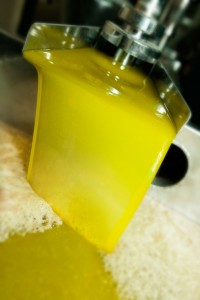The legendary olive tree and the oil obtained from its fruits have accompanied the history of mankind. From the beginning, the olive tree and its fruits have been present in the history of men; whether in sacred rituals or in everyday life, Olive Oil was used not only to enrich food but also in various massage techniques and in cosmetics.
The numerous utensils for harvesting and grinding olives, found by archaeologists in various excavations in the Mediterranean area, as well as many passages from the Bible and the Koran, demonstrate the historical importance of the olive and its oil.
The origin of olive cultivation is uncertain. On the one hand, we know of the oleastro, a thorny bush with small fruits, of little use to man, but widespread in the Mediterranean area. On the other hand, it is thought that in the Copper Age (4000 BC), in the Near East, a variety of large, fleshy fruits was selected, obtained by hybridization between African and Oriental olive trees. The fruit of the olive tree was then immediately used for food purposes. The oil, obtained from olives using still primitive methods, was used for various purposes: as food, as an ointment, as fuel for lamps… The art of medicine itself is based mainly on the use of ointments to apply to the body or concoctions to drink. It is interesting to know that, in Babylon, the doctor was known as “ asu ”, that is, “connoisseur of oils.”
The first olive oil cultivation was therefore developed in a region between Palestine, Crete and Egypt. During this period, olive oil extraction technologies were gradually refined. Later, olive oil became a substance of capital importance in Ancient Greece. There is evidence of the presence of olive trees from the 14th century BC in the area of Mycenae. The importance of this crop is confirmed by a remarkable series of literary references, as well as the presence of the olive tree in mythology. Greek oil production, together with Phoenician oil production, invaded the Mediterranean, transported in ceramic amphorae and leather skins. Each Greek community in the Mediterranean used a different type of amphora, so the origin of the goods could be easily recognised in the markets. Transport in leather skins, which was more limited, is in any case characteristic: the Mediterranean agricultural reality is so conservative that this transport system has persisted until a few decades ago. In the first half of the 20th century in Liguria, Italy, leather skins were still used for short transports of oil.
Although in Greek mythology the origin of Athens itself is related to the planting of the olive tree by Athena, in a fight with Poseidon for supremacy in the protection of the city. To calm the dispute between them, the supreme Zeus intervened, and established that the dominion of that territory would be granted to whoever was capable of providing the most useful gift for humanity. Poseidon brought a horse, a strong, fast animal capable of easing the work of men; Athena, on the other hand, appeared with a small twisted twig in her hands, with fine silver-green leaves. Poseidon was already savoring victory when Athena began to explain the extraordinary properties of the olive tree: a strong plant, capable of living for many years and producing appetizing and tasty fruits, from which men could extract an ideal liquid to season food, give strength to the body, relieve wounds and also light up the night. The victory of the goddess was overwhelming. Zeus declared Athena the winner, giving the citizens the most useful plant and granting her sovereignty over the entire region.
According to mythology, the art of agriculture was taught to mankind by Aristaeus, son of Apollo and the nymph Cyrene. Olive cultivation was so important that Aristaeus also invented the systems for extracting oil, including the olive press.
Olive oil is a vegetable oil used primarily for cooking, extracted from the recently harvested fruit of the olive tree, called the olive. Almost a third of the olive pulp is oil, and for this reason it has been easily extracted from the pulp since ancient times with simple pressure exerted by a primitive mill called an olive press. Its use is primarily culinary, but it has been used for cosmetic purposes, as well as for everyday use in oil lamps. The olive is not usually eaten raw due to its bitter taste (mainly due to the presence of phenolic compounds); this taste is greatly reduced by applying various curing processes. However, 90 % of the world’s olive production is used to produce oil. Only 2% of the world’s production is carried out outside the Mediterranean area. Spain, and to a lesser extent Italy and Greece, account for three quarters of the world’s production.
Olive oil is extracted from olives at the moment when they contain the most oil, at their optimum ripeness, which usually occurs in late autumn and early winter. The olives are first pressed to extract their juice; the quality of the oil depends largely on the subsequent processing. For this reason, producers monitor these steps very carefully. The quality of olive oil is judged by its organoleptic properties and its free fatty acid content. There are regulations in the European Union regarding the classification of olive oils.
It is necessary to distinguish between olive growing and its scientific study (called olive growing) and olive oil extraction and its study (called elaiotecnia, from the Greek elaion meaning oil, of course olive oil). More generally, elaiotecnia is the science that studies the extraction of vegetable oils from any source, such as olive oil, sunflower oil, peanut oil, palm oil, etc.
Nowadays, olive oil is sold in bottles (glass or plastic) as well as in canisters protected from light. The world’s largest producers are located near the Mediterranean Sea, with Spain being the largest producer in the world.
Source: Wikipedia.org